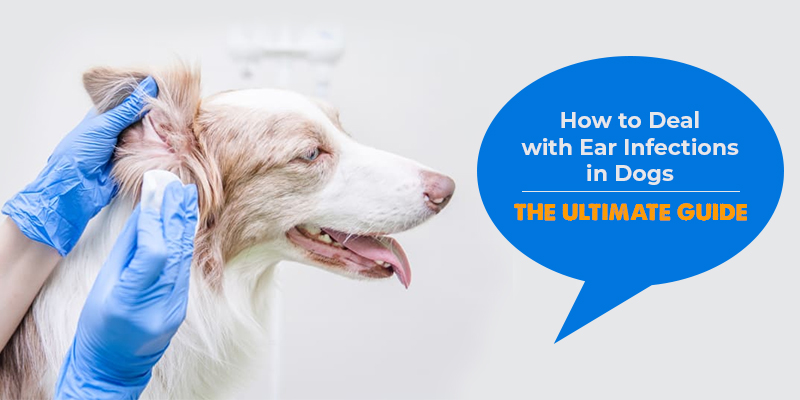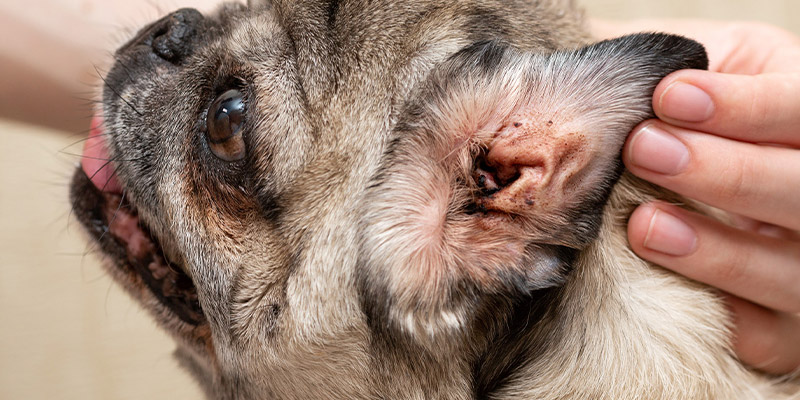
Dogs are lovable and loyal companions, but just like humans, they can also suffer from ear infections. However, as they can’t share their pain and discomfort like we humans can, it is very important to take proper care of your pet, the ear hygiene.
In order to treat and prevent ear infections in dogs, it is important to understand how ear infections occur in dogs, how to diagnose and treat them, and how to prevent them from happening in the first place.
In this blog, we will discuss everything you need to know about ear infections in dogs and how to manage, treat, and prevent them.
Ear Infection in Dogs
Ear infections are most common in dogs, especially in dogs with long, floppy, and hairy ears. Approximately 20 percent of dogs around the world have some form of ear infection, often left untreated. Ear infection without proper medical attention can cause serious damage to the dog, including scarring and narrowing of the ear canal, and even deafness in severe cases.

Types of Ear Infections in Dogs
Depending on the site of infection, ear infections in dogs can be classified as:
-
Otitis externa: This infection affects the external ear canal, causing inflammation and itchiness.
-
Otitis media: This infection affects the middle ear and is mostly developed after severe otitis externa.
- Otitis interna: This infection affects the inner ear and is the most serious condition as it may cause neurological damage leading to permanent deafness.
Causes of Ear Infection in Dogs
Most dogs scratch their ears to relive an itch and there can be various reasons for the itchiness. There are many reasons why dogs scratch their ears. Some primary causes of ear infections in dogs include:
1. Fungal Infections
The most common cause of ear infections in dogs is a fungal or yeast infection. Yeast is generally present on the dog’s fur and skin, but when it outgrows, it causes infection and itching.
The most common species of yeast causing ear infections in dogs include:
- Malassezia pachydermatis
- Candida spp.
These yeasts outgrow and cause infection when there is moisture buildup within dogs’ ears. Furthermore, excessive wax and hair growth also result in the overgrowth of yeast, causing infection.
2. Bacterial Infections
Like fungal infections, bacterial infections also occur by an overgrowth of the bacterial flora within the dog’s ears. When the protective barrier of the dog’s ear skin is damaged due to inflammation or bruised skin, the bacteria multiply at an uncontrollable rate, producing further irritation and discomfort.
Some common bacteria causing ear infections in dogs include:
- Staphylococcus spp.
- Pseudomonas spp.
- Proteus spp.
- Enterococcus spp.
- Streptococcus spp.
- Corynebacterium spp.
3. Allergies
Like humans, dogs also get allergies to certain substances or conditions, like:
- Pollen
- Grass
- Dander
- Dust mites
- Other animals
- Certain food substances
- Human skin cells
- Environmental conditions
When such allergies develop, they cause itching and irritation, leading to inflammation of the skin and ears. The inflammation provides a suitable environment for the yeast and bacteria to multiply and cause infection.
4. Ear Mites
Ear mites are small, microscopic bugs that infest your dog’s ear and cause infections. These mites are present on the grass, sand, and decaying wood. When dogs pick up these mites from their surroundings, they cause severe itching and irritation. This leads to inflamed and bruised ear skin, resulting in an ear infection when left untreated.
The most common types of ear mites causing ear infections in dogs include:
- Otodectes cynotis
Signs and Symptoms of Ear Infections in Dogs
In order to treat ear infections in dogs, it’s important to identify them first. Following are a few signs and symptoms that you must look out for:
- Excessive scratching or rubbing at the ears
- Discharge or foul odor from the ears
- Redness and swelling of the ear canal
- Excessive head shaking (in an awkward and unusual way)
- Scabs and scratches over the skin in the ears
[Also Read] Spotting The Signs Of Pain In Animals
Treatment of Ear Infections in Dogs
As said by the elders, prevention is better than cure, and this holds true for dogs too. By maintaining hygiene and keeping your dog’s ears clean and dry, you can prevent ear infections in the first place.
In cases of severe ear infections, it is of the utmost importance to take your dog to the vet. The vet will be able to properly diagnose the infection and prescribe the appropriate treatment, such as antibiotics or antifungal medications.
To maintain the hygiene and cleanliness of your pet’s ears, it is recommended by vets to use medicated ear cleaners frequently.
Some effective ear cleaners for dogs include:

These ear cleaner solutions contain potent antifungal and antibacterial ingredients that keep the fungal and bacterial flora in your dog’s ears in check. Furthermore, they help remove excessive wax, debris, and dirt from the ears, preventing any potential infections or discomfort for your pet. With their regular use, you can also prevent unpleasant odors and maintain overall ear health in dogs.
Wrapping Up – Protect Your Dog from Ear Infections
Ear infections are highly uncomfortable and troublesome for dogs. They cause pain, itching, and discomfort and can lead to more serious health issues if left untreated. By using ear cleaner and maintaining hygiene in your dog’s ears, ear infections can be prevented.
It is important to seek veterinarian advice if the infection persists. Treating and managing ear infections in time can prevent potential hazards and provide comfort and relief to your pet.
The post How to Deal with Ear Infections in Dogs: The Ultimate Guide appeared first on CanadaVetCare Blog.

